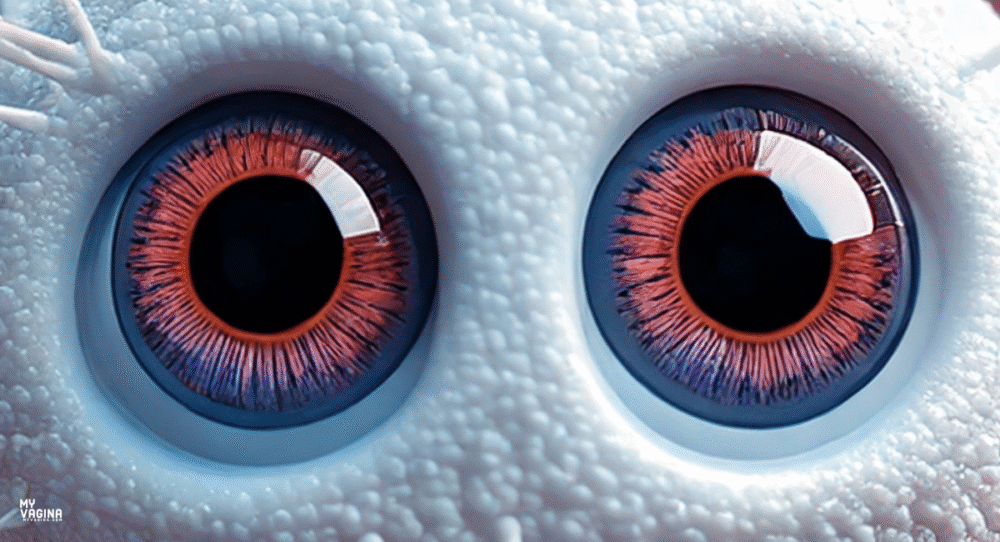Sexually transmitted infections (STIs) usually at first affect mainly the genitourinary tract, but they can also infect or affect other areas of the body, including the eyes.
Most people don’t associate sexually transmitted infections (STIs) with their eye health, so joining these dots can be tricky.
Early signs of an STI-related eye infection
- Diffuse or localised eye redness
- Gritty, burning sensation
- Mild irritation
- Mild itching
- Rapid-onset conjunctivitis
- Watery or mucousy discharge, which may start clear and then develop pus (common in early chlamydia or viral infections)
- Quick onset of copious, thick, yellow-green discharge (most common with gonorrhoea infections)
- Swollen, puffy, crusty eyelids – tends to be mild at first, but worsens rapidly with gonorrhoea
- Sticky, crusty eyes upon waking (most common with bacteria)
- Teary eyes – which is an early sign of irritation or corneal involvement, more likely with herpes (HSV) or gonorrhoea that has reached the cornea
- Light sensitivity (suggests possible corneal inflammation/keratitis)
- Foreign body sensation, gritty, sandy feeling in the eye, a very common complaint with chlamydia or HSV
- Mild blurred vision, a sign of the cornea or deeper structural inflammation
- Eye pain – ranges from a mild ache (chlamydia or early HSV) to a sharp pain (gonococcal) and indicates the depth of infection
- Mild vision changes, floaters, nonspecific redness – typically associated with syphilis and human immunodeficiency virus (HIV)
Early signs of STI-related eye infection in newborns
- May occur after a vaginal delivery
- Severely swollen eyelids
- Redness
- Copious discharge that starts within days or weeks after birth (gonococcal, chlamydia, HSV)
How does an STI get to the eye?
STI transmission to the eye can occur via direct contact, for example, touching infected genital fluids, then touching the eye, but can also include transmission to an infant during birth. Impacts of infections may occur via the bloodstream and affect multiple organ systems, including the eyes.
Prevention and treatment
Early recognition of the signs and symptoms of an STI having spread to or impacting the eyes, as well as prompt treatment, can prevent complications such as loss of vision, corneal scarring, or eye inflammation. Early intervention can also help prevent the spread of infections to other family members and sexual partners.
When being treated for STIs, it’s useful to know which STIs can affect the eyes and what to look out for.
STIs that can affect the eyes
- Gonorrhoea (Neisseria gonorrhoeae)
- Chlamydia (Chlamydia trachomatis)
- Syphilis (Treponema pallidum)
- Herpes Simplex Virus (HSV)
- Human Immunodeficiency Virus (HIV)
Common misconceptions about STIs and eye health include:
- STIs can’t affect the eyes
- If I don’t have genital symptoms, I can’t get an STI in my eye
- Eye infections from STIs are extremely rare
- Over-the-counter eye drops will cure it
- It’s just pink eye – it’ll go away by itself
- Eye infections from STIs only happen to ‘promiscuous’ people
- If a baby has an STI-related eye infection, it’s from sexual abuse
- You can only catch an eye STI if an infected genital touches your eye
- STIs don’t cause serious eye damage
- I can’t spread my eye STI to others
Talking about STIs and eye health
It’s useful to discuss STI-related eye symptoms with your doctor or pharmacist. If you’re already getting treatment for an STI and develop eye symptoms, talk to your doctor.
Sexually transmitted infections come with a lot of stigma and misunderstandings, so these conversations can be delicate. If an STI-related eye infection is suspected, head to the doctor to be tested and get a prescription. Eye infections can be dangerous over the longer term, so don’t wait.
Linking STIs and eye symptoms – it’s not always clear
Linking eye symptoms with an STI may feel very left of field, and come with a lot of misconceptions about STIs and the eyes.
Chlamydia, for example, has several serovars (types) that affect only the eyes, not the genitals or pelvic organs, and many infections are highly contagious and can be spread easily from hands to eyes, and between family members where no sexual contact has occurred.
Think of this a little like head lice or pinworms, if that is helpful in terms of reducing the risk of transmission from hand-to-eye or object-to-eye contact at home. There are potentially serious negative outcomes that are possible without speedy treatment.
An STI must be detected and diagnosed by a doctor before the correct medication can be prescribed, so if someone is complaining of chronic conjunctivitis, blurry vision or other symptoms as listed, the eyes and genitals can be tested and treated.
Handling STI-related eye infections and symptoms
In the case of unusual or severe conjunctivitis, an STI may be the cause, and can be caught from a home environment rather than direct sexual contact, so testing should be thorough.
Antibiotic eye treatments
Treatment for STIs is prescription-only, however there are some over-the-counter products that can help provide some relief while the STI is being treated with prescribed medication.
- Pharmacy-only eye drops for non-STI bacterial conjunctivitis include chloramphenicol 0.5%, but these drops are usually ineffective for gonococcal or chlamydial infections.
- The 1% eye ointment is usually applied at night for mild bacterial conjunctivitis.
- These two products should be used cautiously if STI is suspected, since gonorrhoea and chlamydia are often resistant to standard OTC antibiotics, and infections can worsen quickly if they are not effectively treated promptly.
Non-antibiotic symptom relief
- Lubricating eye drops like polyvinyl alcohol or carboxymethylcellulose (Refresh, Systane, etc.) can soothe irritation and dryness.
- Saline washes or eye baths can gently rinse away discharge.
- These treatments do not kill bacteria, but may provide some relief to the eyes.
What not to use if you suspect an STI-related eye infection
Antihistamine or decongestant drops are not recommended for STI-related infections, as while the symptoms may mimic allergic symptoms, these treatments will delay the appropriate treatment for longer, potentially resulting in eye damage.
Helplines for confidential conversations
If you have questions, contact a free nurse or doctor medical helpline in your country.
Emerging trends in STIs and eye health – ocular syphilis
Syphilis rates are increasing globally, including in Australia, particularly in remote areas. In 2022, in Australia, over 6,000 people were diagnosed. Syphilis can affect the eyes, in what’s known as ocular syphilis, with uveitis the most common manifestation.
Without treatment, ocular syphilis results in blindness through various mechanisms of eye inflammation and can occur at any stage of infection.
References1,2
- 1.Furtado JM, Simões M, Vasconcelos-Santos D, et al. Ocular syphilis. Survey of Ophthalmology. Published online March 2022:440-462. doi:10.1016/j.survophthal.2021.06.003
- 2.Abu Samra K, Azzouni F. The eye in sexually transmitted infections: a review of the ocular complications of venereal diseases. Int Ophthalmol. Published online December 2011:539-550. doi:10.1007/s10792-011-9501-5








